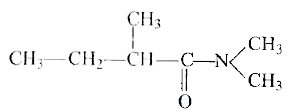CH3−O−CH2CH3HI/Δ−−−−−→Excess(A)+(B)
Product (A) and (B ) are
CH3OH+CH3CH2I
CH3I+CH3CH2OH
CH3I+CH3CH2I
CH3OH+CH3CH2OH
The correct Answer is:D
To solve the problem of what products (A) and (B) are formed when CH₃OCH₂CH₃ is treated with excess HI under heating, we can follow these steps:
Step 1: Identify the Reactants
The reactant is an ether, specifically ethyl methyl ether (CH₃OCH₂CH₃).
Step 2: Understand the Reaction Conditions
The ether is treated with excess hydrogen iodide (HI) and heated. HI is a strong acid that can cleave ethers.
Step 3: Mechanism of Ether Cleavage
When the ether is treated with HI, the oxygen atom in the ether can abstract a proton (H⁺) from HI, resulting in the formation of an oxonium ion (CH₃OH⁺CH₂CH₃). This step makes the ether more reactive.
Step 4: Nucleophilic Attack
The iodide ion (I⁻), which is generated from the dissociation of HI, can now act as a nucleophile. It can attack one of the carbon atoms adjacent to the oxygen atom in the oxonium ion.
Step 5: Formation of Products
1. The iodide ion can attack the methyl group (CH₃) leading to the formation of methyl iodide (CH₃I) and ethanol (CH₃CH₂OH).
2. Alternatively, the iodide ion can attack the ethyl group (CH₂CH₃), leading to the formation of ethyl iodide (CH₃CH₂I) and methanol (CH₃OH).
Step 6: Excess HI Effect
Since HI is in excess, the alcohols formed (methanol and ethanol) can further react with HI:
- Methanol (CH₃OH) can react with HI to form methyl iodide (CH₃I).
- Ethanol (CH₃CH₂OH) can react with HI to form ethyl iodide (CH₃CH₂I).
Step 7: Final Products
The final products after all reactions are:
- Product A: Methyl iodide (CH₃I)
- Product B: Ethyl iodide (CH₃CH₂I)
Conclusion
Thus, the products (A) and (B) are:
- A = CH₃I (Methyl iodide)
- B = CH₃CH₂I (Ethyl iodide)
Answer
The correct answer is option C: CH₃I and CH₃CH₂I.
---
The reactant is an ether, specifically ethyl methyl ether (CH₃OCH₂CH₃).
The ether is treated with excess hydrogen iodide (HI) and heated. HI is a strong acid that can cleave ethers.
When the ether is treated with HI, the oxygen atom in the ether can abstract a proton (H⁺) from HI, resulting in the formation of an oxonium ion (CH₃OH⁺CH₂CH₃). This step makes the ether more reactive.
The iodide ion (I⁻), which is generated from the dissociation of HI, can now act as a nucleophile. It can attack one of the carbon atoms adjacent to the oxygen atom in the oxonium ion.
1. The iodide ion can attack the methyl group (CH₃) leading to the formation of methyl iodide (CH₃I) and ethanol (CH₃CH₂OH).
2. Alternatively, the iodide ion can attack the ethyl group (CH₂CH₃), leading to the formation of ethyl iodide (CH₃CH₂I) and methanol (CH₃OH).
Since HI is in excess, the alcohols formed (methanol and ethanol) can further react with HI:
- Methanol (CH₃OH) can react with HI to form methyl iodide (CH₃I).
- Ethanol (CH₃CH₂OH) can react with HI to form ethyl iodide (CH₃CH₂I).
The final products after all reactions are:
- Product A: Methyl iodide (CH₃I)
- Product B: Ethyl iodide (CH₃CH₂I)
Thus, the products (A) and (B) are:
- A = CH₃I (Methyl iodide)
- B = CH₃CH₂I (Ethyl iodide)
The correct answer is option C: CH₃I and CH₃CH₂I.
Similar Questions
Knowledge Check
CH3−CH2−CH2−CH3AlCl3−−−−−→ΔCH3−CH∣CH3−CH3
Above reaction is an example of :AisomerizationBpolymerizationCcrackingDde-hydrogenationH3C−CH2−CH3∣CH−C∣∣O−NH2Br2+KOH−−−−−−−−−→ΔA1.CH3I(excess)−−−−−−−−−−−−→2.AgOH,ΔB
The major product (B) is :ACH3−CH2−CH=CH2B CH3C−CH=CH−CH3D
CH3C−CH=CH−CH3D
CH3CH2−O−CH3anhyHI−−−−→? Product is
View SolutionI. CH3−CH2−CH2−CH2−OH
II. CH3−CH2−CH∣OH−CH3
III. CH3−CH3∣C∣OH−CH3
IV. CH3−CH∣CH3−CH2−OH
V. CH3−CH2−O−CH2−CH3
VI. CH3−O−CH2−CH2−CH3
VII. CH3−O−CH∣CH3−CH3
Which of the above compounds form pairs of metamers ?
View SolutionI. CH3−CH2−CH2−CH2−OH
II. CH3−CH2−CH∣OH−CH3
III. CH3−CH3∣C∣OH−CH3
IV. CH3−CH∣CH3−CH2−OH
V. CH3−CH2−O−CH2−CH3
VI. CH3−O−CH2−CH2−CH3
VII. CH3−O−CH∣CH3−CH3
Identify the pair of compounds that represents chain isomerism
View SolutionI. CH3−CH2−CH2−CH2−OH
II. CH3−CH2−CH∣OH−CH3
III. CH3−CH3∣C∣OH−CH3
IV. CH3−CH∣CH3−CH2−OH
V. CH3−CH2−O−CH2−CH3
VI. CH3−O−CH2−CH2−CH3
VII. CH3−O−CH∣CH3−CH3
Identify the pairs of compounds which are functional group isomers
View SolutionI. CH3−CH2−CH2−CH2−OH
II. CH3−CH2−CH∣OH−CH3
III. CH3−CH3∣C∣OH−CH3
IV. CH3−CH∣CH3−CH2−OH
V. CH3−CH2−O−CH2−CH3
VI. CH3−O−CH2−CH2−CH3
VII. CH3−O−CH∣CH3−CH3
Identify the pairs of compounds that represents position isomerism.
View SolutionThe major product [B] in the following reaction is :
CH3−CH3−CH| CH−CH2−OCH2−CH3HI−−→Heat[A] alcoholH2SO4−−−→Δ[B]
View Solution
